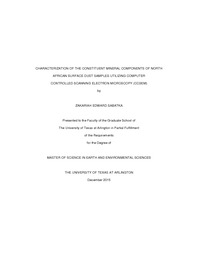
ATTENTION: The works hosted here are being migrated to a new repository that will consolidate resources, improve discoverability, and better show UTA's research impact on the global community. We will update authors as the migration progresses. Please see MavMatrix for more information.
Show simple item record
| dc.contributor.advisor | Hunt, Andrew | |
| dc.creator | Sabatka, Zakariah Edward | |
| dc.date.accessioned | 2016-01-27T21:30:38Z | |
| dc.date.available | 2016-01-27T21:30:38Z | |
| dc.date.created | 2015-12 | |
| dc.date.issued | 2015-12-23 | |
| dc.date.submitted | December 2015 | |
| dc.identifier.uri | http://hdl.handle.net/10106/25495 | |
| dc.description.abstract | Analysis of the constituent mineral components of surface dusts/soils from Chad-Niger region, North Africa, was undertaken by computer controlled scanning electron microscopy (CCSEM) to determine if differences in composition could be used for source attribution to distinguish windblown material from different contributing source areas. A total of 11 surficial samples were selected for analysis by computer controlled scanning electron microscopy (CCSEM). These samples were from two different geographic locations in the Chad-Niger region. CCSEM analysis generates data on individual dust particles that includes: particle size, shape, and chemical composition. This type of particle characterization used a Scanning Electron Microscope (SEM) working in the Backscattered Electron Imaging (BEI) mode. The BEI mode of imaging of microscopic dust particles provided information on particle morphology, and average atomic number composition. Element data on Individual particles was provided by a Silicon Drift X-ray detector with an ultra-thin window.
The principal goal of this project was to assess whether surface dusts, at the individual particle level, from two different locations in the Chad-Niger region of North Africa, could be satisfactorily differentiated. The mineralogy of the individual particles from the dust samples was determined by CCSEM. CCSEM analysis provides data on thousands of particles in a time efficient manner. Consequently statistically significant sized data sets can be evaluated.
With surface soils/dust particles it is typically unhelpful in CCSEM analysis to define specific mineral particle types. Certainly, obdurate minerals such as quartz can often be recognized in CCSEM data (Particles composed wholly of Si). However, transformation processes, like the formation of Fe coats on particles, alters the composition of basic mineral forms in terms of the chemical composition identified in the SEM. To provide a realistic classification of the particles analyzed here. A reference data set from the analysis of a North African surface dust sample was used to develop a classification scheme. An assisted cluster analysis was used to identify homogenous groups of particles within the reference data set. Homogenous groups of particles were based on associations of the constituent particle elements. The homogenous groups were assembled into a 59-class element-based classification scheme. The classes were listed in a linear sorting order that was used to classify the CCSEM data from the samples investigated in this study. The study sample CCSEM analysis typically contained element and other data on approximately 4,000 particles per sample. | |
| dc.format.mimetype | application/pdf | |
| dc.language.iso | en_US | |
| dc.subject | Mineralogy | |
| dc.subject | Scanning Electron Microscopy | |
| dc.title | Characterization of the Constituent Mineral Components of North African Surface Dust Samples Utilizing Computer Controlled Scanning Electron Microscopy (CCSEM) | |
| dc.type | Thesis | |
| dc.date.updated | 2016-01-27T21:32:45Z | |
| thesis.degree.department | Earth and Environmental Sciences | |
| thesis.degree.grantor | The University of Texas at Arlington | |
| thesis.degree.level | Masters | |
| thesis.degree.name | Master of Science in Earth and Environmental Science | |
| dc.type.material | text | |
| dc.creator.orcid | 0000-0003-2233-7248 | |
Files in this item
- Name:
- SABATKA-THESIS-2015.pdf
- Size:
- 5.931Mb
- Format:
- PDF
This item appears in the following Collection(s)
Show simple item record


